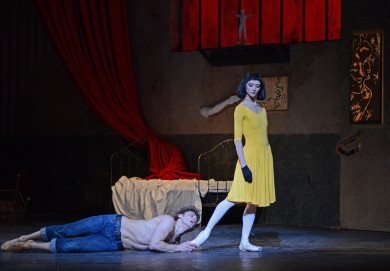The festival closing with a gala concert featuring soloists of the Mariinsky Ballet Company and guest soloists.
Divertissement
PERFORMERS
Conductor: Boris Gruzin
Elena Yevseyeva and David Zaleyev
Maria Alexandrova and Vladislav Lantratov
Maria Khoreva and Vladimir Shklyarov
Ekaterina Kondaurova and Roman Belyakov
Léonore Baulac and Germain Louvet
Viktoria Tereshkina and Alexander Sergeev
Age category 6+
Le Jeune homme et la mort
PERFORMERS
Conductor: Boris Gruzin
Kimin Kim and Eleonora Abbagnato
CREDITS
To music by Johann Sebastian Bach
(Passacaglia in С Minor, BWV 582, arranged for full orchestra by Alexander Goedicke)
Libretto by Jean Cocteau
Choreography by Roland Petit
Production Choreographer: Luigi Bonino
Set Designer: Georges Wakhevitch
Costume Designer: Karinska
Lighting Designer: Jean-Michel Désiré
ABOUT THE PRODUCTION
The ballet Le Jeune homme et la mort, staged in 1946 in Paris, reflected the spirit of the post-war era and became one of the most well-known works of choreographer Roland Petit and one of the most sought-after ballets by dancers of different generations. Roland Petit initially created the dancing routines for a mini-production to a popular jazz song, but just before the premiere Jean Cocteau, mastermind and source of inspiration for the ballet, suggested changing the music to Bach’s Passacaglia. There was no talk of matching the movements to musical focal points; during the first performance the creators were afraid that the Passacaglia would not be long enough for the choreography. However, thanks to Bach’s music, the theme of an artist’s conversation with death, which is raised in the ballet, has acquired dimension and scope. Drama about the meeting of a restless artist with a fatal beauty was protected from melodrama. Bach’s Passacaglia helped the performers to get away from realism: from the specifics of the things scattered in the artist's room to the state of chaos required by Cocteau, from the youth's single-valued glance at the clock to the sense of timelessness. The nerve of the meeting shown at the scene was familiar to post-war Europe, then almost everyone in the auditorium could subscribe to Jean Cocteau's words: "I have experienced such painful periods that death seemed a temptation. I'm used to not being afraid of her and looking straight into her face".
Olga Makarova
World premiere: 25 June 1946, Théâtre des Champs Élysées, Paris
Premiere at the Mariinsky Theatre: 25 March 1998
Premiere of the revival: 22 March 2012
Running time 16 minutes
Production Sponsor: Toshihiko Takahashi
Age category 16+
Symphony in C
PERFORMERS
Conductor: Boris Gruzin
I. Allegro vivo
Yekaterina Osmolkina
Maxim Zyuzin
II. Adagio
Alina Somova
III. Allegro vivace
Renata Shakirova
Philipp Stepin
IV. Allegro vivace
Alexei Timofeyev
Full cast to be announced at a later date
CREDITS
Music by Georges Bizet (Symphony No. 1 in C)
Choreography by George Balanchine (1947)
Staging by Colleen Neary
Costume design by Irina Press
ABOUT THE PRODUCTION
George Balanchine staged one of his most famous ballets for the company of the Opéra de Paris in 1947. Invited from beyond the ocean, the choreographer, in executing the French commission, was absolutely sure of himself: in this new work, as in most mature ballets by Balanchine, there was no plot, there were no human passions behind the dance, and only the music, its rhythm and structure determined the development of the choreographic image. The character of the dance was dictated by Georges Bizet’s youthful Symphony in C Major. Its sparkling lightness provided the name of the work – Le Palais de cristal. It is true that soon after the ballet was brought to New York the invented title became forgotten, and for over half a century many leading ballet companies throughout the world have been proud to have Balanchine’s Symphony in C in their repertoires. This ballet is ideal for showcasing a company’s merits: the four parts of the ballet are staged for four pairs of soloists, and in this ballet dancers can dazzlingly show off their skills and take on the incredibly complex fiorituri of the shading in the allegro, and proudly and majestically “sail” into the adagio.
Olga Makarova
World premiere: 28 July 1947, Théâtre National de l'Opéra, Paris
Premiere at the Mariinsky Theatre: 9 February 1996
Running time: 40 minutes
The ballet of George Balanchine Symphony in C is presented by arrangement with The George Balanchine Trust and has been produced in accordance with the Balanchine Style® and Balanchine Technique® service standards established and provided by the Trust
The Mariinsky Theatre would like to express its gratitude to Mrs Bettina von Siemens for her support in bringing the “Ballets of George Balanchine” project to life
Age category 6+
 Mariinsky Theatre:
Mariinsky Theatre:  Mariinsky-2 (New Theatre):
Mariinsky-2 (New Theatre):  Mariinsky Concert Hall:
Mariinsky Concert Hall: 

